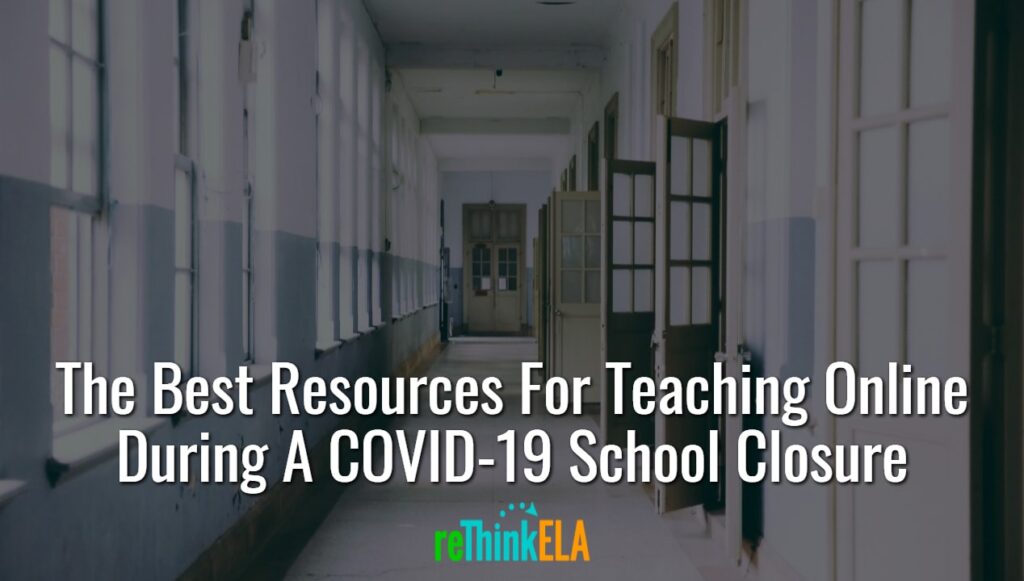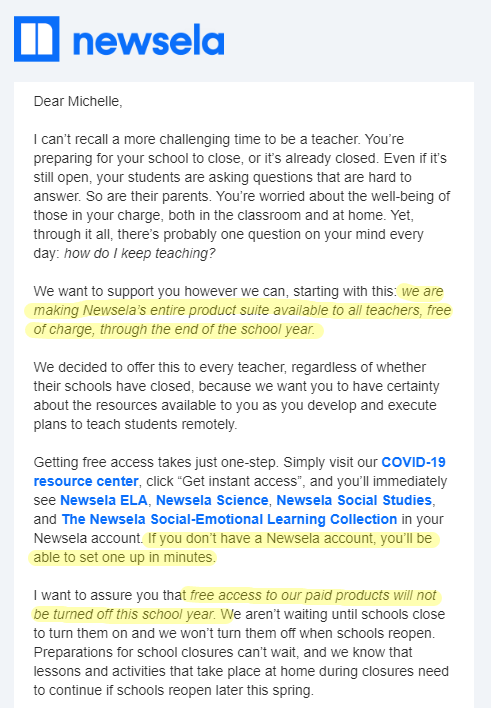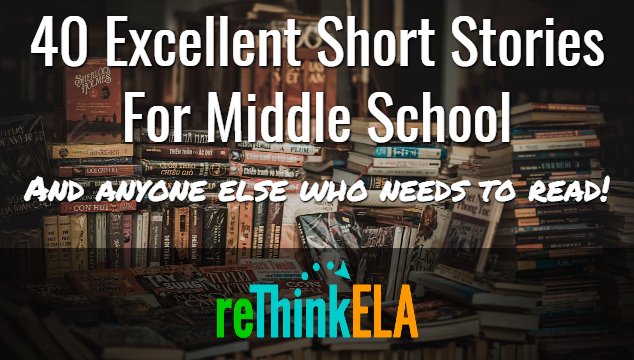
Note: If you’re an early education teacher, check out this list of curated resources.
Updates for Teachers
- Cody Miller: Project ideas for distance learning (opens in Twitter)
- Tara Martin: BookSnaps – Snapping for Learning (Think: Just about every middle or high school kid has SnapChat, right?)
- Brent Enerva: Choice Board Template for Distance Learning (opens in Twitter)
- Pernille Ripp: Choose Your Own Adventure – 4 Learning Options As We Go Virtual/Online
- HyperDocs: How to create hyperdocs to facilitate student-centered, inquiry-based remote learning opportunities
- Digital Public Library of America: DPLA is offering free online resources for teachers, students, and everyone
- Alice Keeler: Distance Learning with Google Slides
- EdSurge: Coronavirus Has Led to a Rush of Online Teaching. Here’s Some Advice for Newly Remote Instructors
- WBUR: Separated By A Screen? Advice For Online Teaching Amid The Coronavirus Outbreak
- Andrew Boatman: A list of resources for computer class (Editor’s Note: Some tools listed could be used to create digital products in ELA class.)
- NCTE: Just in Case You Thought No One Was Listening… (Editor’s Note: See associated Tweet here.)
- NCTE: Resources for Virtual Instruction and Online Learning
- SKH: Apps for Dyslexic, Autistic, Dysgraphic, & Visually Impaired Learners…. (Opens in Twitter)
My Twitter and Facebook feeds have been full of educators talking about their schools closing or what they will do if their schools close in the future.
I teach at a small school in Oklahoma, a state which has not been as heavily impacted by the coronavirus pandemic as other states. While some nearby K-12 districts have closed early or announced plans to close after Spring Break, which is next week, my district has not.
However, I have been following the discussions online for the past several days so I can be prepared in case we do, and so I can help support members of the reThink ELA community who are scrambling to support students during a school closure.
[bctt tweet=”English teachers need to model what we are teaching our students, so our students need to see us grappling with the impact of this unfolding #coronavirus situation in #writing.” username=”watersenglish”]
Of course, Kelly Gallagher shares my view of what students need to be doing during this historic and unprecedented pandemic response in our country: My answer of course, no matter what is happening, is always going to be write about it. Share your truth.
My students all have access to Google Docs and Google Classroom (if they have a computer or phone and Internet) and we use these extensively in class. I have also worked with them on sitting down and just writing on either a topic they’re given, or one of their choosing, for five minutes every day. I call it quickwriting, and it’s a perfect way for them to jot down their thoughts and feelings as they live through this coronavirus outbreak.
My “assignment” for them, if we shut down (and even if we don’t), is to write about how this pandemic is impacting their lives. By doing this, they will be creating primary documents that they and others can look back on decades from now to revisit and share their experiences.
That said, I know some students need more scaffolding and others struggle with writing to the point that they resist it vehemently.
[bctt tweet=”Here are some additional resources educators across Twitter and Facebook have curated to help us all find ways to bring school into students’ homes.” username=”watersenglish”]
Blended Learning Tools
Scott Bayer, co-founder of #THEBOOKCHAT and 6-12 ELA instructional specialist in Montgomery County, Maryland, recorded a video conference in which he provides an overview of three blended learning tools.
This video covers three different options for creating an online learning environment for students who have technology access at home: hyperdocs, task boards, and playlists.
I believe that when we leverage technology for specific purposes, our pedagogy shifts to create a more engaging, meaningful, and equitable learning environment for our students.
Scott Bayer in How to Shift the Dynamic in Your Classroom and Make Yourself a Facilitator of Learning.
If you’re wanting to gain an overview and some specifics on how to start creating an effective distance learning environment for use during COVID-19 school closures, or even in your classroom if you have the technology available, watch the video.
Online Resources
Some authors are offering to answer questions from their readers via Twitter during any coronavirus quarantine they may be experiencing. Consider Lauri Halse Anderson, who is a young adult novel author.
Jennifer Williams, reThink ELA author and joint venture partner who wrote Grammar Conversations and Educational Technology Integration Specialist at the University of Oklahoma, shared a few online online teaching resources that our free to teachers during this coronavirus crisis in the RTE Facebook group.
Newsela
Newsela, which offers leveled high-interest articles for students to read, is providing free access through the end of the year. Students can login, read articles on topics of their interest, and participate in assessments and activities. Teachers can see their progress through the program. I’ve used this program and similar ones, which are good options for teachers who have students with diverse interests and varying levels of reading stamina and willingness.

Scholastic
You are probably familiar with Scholastic’s Scope Magazine which provides a ton of reading resources, which I’ve used at the middle school level. My students have historically loved their reader’s theater options, such as Edgar Allen Poe’s The Tell-Tale Heart. While this story worked well in the classroom, Scholastic is now offering free online resources you can connect your students to during the COVID-19 crisis.
Cherokee High School English Teacher Michelle Baldwin suggested in the RTE Facebook Group that we check out Zoom, a video conferencing website.
Zoom
If your students can access a video conference room for you to teach in, or access a recording of your teaching, then Zoom is an excellent tool. It’s one I’ve used for podcasting and for meeting with colleagues from around the country. If your school provides 1-to-1 access to devices and all of your students have Internet access, this may be an option for you to facilitate learning online.
Study Island
This online learning platform is offering two free months of access to schools that are closed as a result of the pandemic.
Need access to quality online programming due to school closures? Edmentum would like to provide free program access to Study Island for Home, two free months of access to Study Island, or two free courses in EdOptions Academy to any school or district who has shut down due to this virus.
Read more at Edmentum.com.
Here at RTE, we also provide resources that can be used in an online environment, as well as in the classroom.
RTE Short Stories

RTE has a growing list of short story resources that you can access individually for free. If you’d like to provide your students with a short story to read, related, nonfiction articles, and/or audio options, you can sign up for them on this page.
Just download the PDF of the short story and upload it to your learning platform, such as Google Classroom. You can also include the link to the audio or movie versions that are available on YouTube.
A List of Additional Tools
- A representative of Writing Legends contacted me yesterday to share a resource based in New Zealand, but that is being released to teachers for free until July 31 as a result of the COVID-19 school closures.
- A member of the RTE Facebook Group suggested “7 Websites to Download PDF Books.”
What kind of assignments can I give my students in English class?
Below are some ideas I have found around the Internet or that the reThink ELA community has shared with me. Feel free to reply to this post with your ideas!
First up is a thread by Jess Lifshitz, a 5th grade teacher in Illinois. Click the tweet box to open up the whole thread and scroll through all the ideas she has. I already found a few nuggets of gold I plan to use whether we’re in school or not.
What about students with no internet?
Tolly Salz, who teaches at Episcopal School of Dallas, has linked to some ideas on how to make sure our marginalized students are taken care of during this crisis.
Jess Lifshitz has also provided some insight into how to support students who are forced to stay at home during the pandemic.
What about the emotional impact of the COVID-19 Pandemic?
Marisa Thompson, a reThink ELA podcast guest and Carlsbad, California educator, suggests that we focus on helping students through this crisis and less on giving them more work to do.
To be honest, for now, I won’t be asking them to do anything. Everyone needs to do what they need to do right now and my class is not one of those things.
We will put some things online but they will be optional. We have students without internet, and this isn’t the priority at this time. If we can take a two week winter break we can take three weeks without prescribed learning. (My view, not my districts words.)
Marisa Thompson via Twitter DM
Ideas?
What are you doing — or planning to do — to take your classroom online? Please share in the comments!

I’m a teacher candidate supervisor, working with many mentor teachers and student teachers. As I shift through the myriad of resources available, I find VERY LITTLE that supports K-2 teachers in their virtual environment. Can you point specifically to any of the resources ReThinkELA has found that specifically help these teachers? Do any other readers of this site feel the same, or have they found resources? Could ReThinkELA find a way to organize or highlight these resources on your site?! Thanks SO MUCH.
I have curated an article of resources for early education teachers. You can find them here.
Hi Diane!
Thank you so much for asking. My expertise is in 6-12, but I know tech integration specialists and K-2 teachers who are really good with technology. I’m going to contact them, ask for their input, and then update you here. Have a great day!